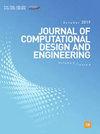An finite element analysis surrogate model with boundary oriented graph embedding approach for rapid design
IF 6.1
2区 工程技术
Q1 COMPUTER SCIENCE, INTERDISCIPLINARY APPLICATIONS
引用次数: 0
Abstract
In this work, we present a Boundary Oriented Graph Embedding (BOGE) approach for the Graph Neural Network (GNN) to assist in rapid design and digital prototyping. The cantilever beam problem has been solved as an example to validate its potential of providing physical field results and optimized designs using only 10ms. Providing shortcuts for both boundary elements and local neighbor elements, the BOGE approach can embed unstructured mesh elements into the graph and performs an efficient regression on large-scale triangular-mesh-based FEA results, which cannot be realized by other machine-learning-based surrogate methods. It has the potential to serve as a surrogate model for other boundary value problems. Focusing on the cantilever beam problem, the BOGE approach with 3-layer DeepGCN model achieves the regression with MSE of 0.011706 (2.41% MAPE) for stress field prediction and 0.002735 MSE (with 1.58% elements having error larger than 0.01) for topological optimization. The overall concept of the BOGE approach paves the way for a general and efficient deep-learning-based FEA simulator that will benefit both industry and CAD design-related areas.面向边界的图形嵌入快速设计有限元分析代理模型
在这项工作中,我们提出了一种面向边界的图嵌入(BOGE)方法,用于图神经网络(GNN),以协助快速设计和数字原型。以悬臂梁问题为例,验证了其仅在10ms内提供物理场结果和优化设计的潜力。BOGE方法提供了边界元素和局部邻近元素的快捷方式,可以将非结构化网格元素嵌入到图中,并对基于三角网格的大规模有限元结果进行有效的回归,这是其他基于机器学习的代理方法无法实现的。它有可能作为其他边值问题的替代模型。针对悬臂梁问题,采用3层DeepGCN模型的BOGE方法实现了应力场预测的MSE为0.011706 (MAPE为2.41%),拓扑优化的MSE为0.002735(误差大于0.01的元素为1.58%)。BOGE方法的总体概念为通用和高效的基于深度学习的有限元模拟器铺平了道路,这将有利于工业和CAD设计相关领域。
本文章由计算机程序翻译,如有差异,请以英文原文为准。
求助全文
约1分钟内获得全文
求助全文
来源期刊

Journal of Computational Design and Engineering
Computer Science-Human-Computer Interaction
CiteScore
7.70
自引率
20.40%
发文量
125
期刊介绍:
Journal of Computational Design and Engineering is an international journal that aims to provide academia and industry with a venue for rapid publication of research papers reporting innovative computational methods and applications to achieve a major breakthrough, practical improvements, and bold new research directions within a wide range of design and engineering:
• Theory and its progress in computational advancement for design and engineering
• Development of computational framework to support large scale design and engineering
• Interaction issues among human, designed artifacts, and systems
• Knowledge-intensive technologies for intelligent and sustainable systems
• Emerging technology and convergence of technology fields presented with convincing design examples
• Educational issues for academia, practitioners, and future generation
• Proposal on new research directions as well as survey and retrospectives on mature field.
 求助内容:
求助内容: 应助结果提醒方式:
应助结果提醒方式:


